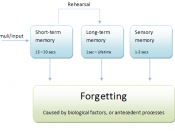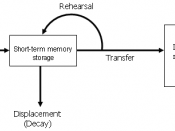The cognitive approach in psychology deals with human thought and mental processes such as memory, remembering and problem solving. The cognitive approach is interested in how people take in information, how they mentally represent it and how they store it. It also looks at how the information is perceived and processed and how integrated patterns of behaviour occur.
Memory is fundamental to our lives, we have to recall who we are, recognise the faces of everyone we meet and remember how to move and communicate. Several models of the way in which memory is structured and how it functions have been advanced and although there are many differences between the models, they all view memory as a means of processing information. We do not simply record information, we carry out some sort of processing as we eliminate, store, organise and reconstruct the information we receive. This information processing occurs in three stages: encoding, storage and retrieval.
Encoding involves converting the information we receive from our senses into something that we represent mentally Storage involves holding information over a period of time in preparation for when it is needed, and retrieval involves recovering stored information.
There are three models of memory; one of these is the multi store model. Atkinson and Shiffrin (1968) proposed an influential multi- store model, which suggested that there are three types of information store. The three types of memory stores are the sensory store, the short term store and the long term store.
When a stimulus invades on our senses then the information passed from the sensory store, onto the short term store and then into long term store. Short Term Memory (STM) has an extremely limited capacity between five and nine. Miller (1956) suggested that the capacity of STM is "The Magic Number Seven, Plus...


